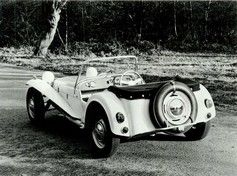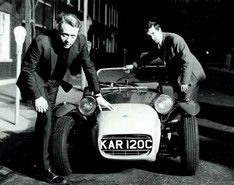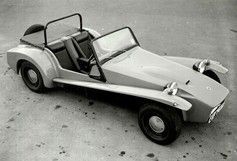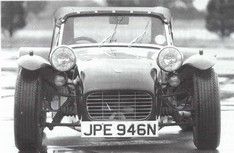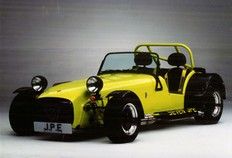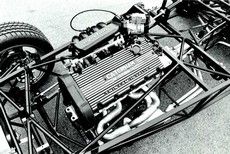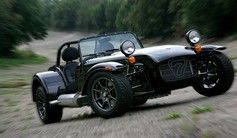The Magnificent Seven
Graham Bell charts half a century of this iconic sports car
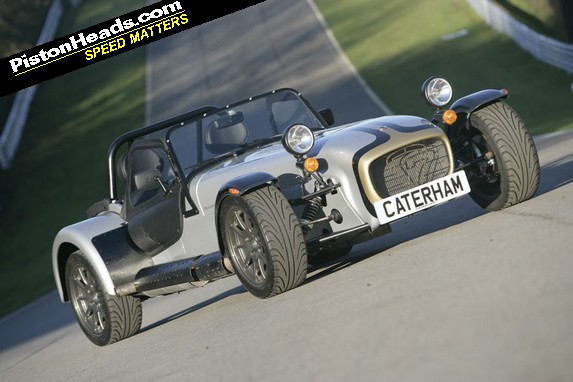
However, contrary to what many people seem to think, the Seven wasn’t the first car of this type (that was the Buckler Mk5 of 1947) though it is undoubtedly the best known. That’s partly because the company who originally made it also made championship winning Formula 1 cars, and partly because it’s the only one that’s been in production for 50 years.
Launched with Ford’s 1172cc side valve engine producing up to 40bhp in twin carburettor form and backed up by a 3-speed gearbox, the original Seven did 0-60 in just over 16 seconds and ran out of steam around 80mph. That was pretty good in 1957, and combined with the lightweight Seven’s nimble handling made for a highly effective clubman’s racer, the factory prototype taking victory in the Seven’s very first race.
Inevitably the demands of competition soon called for more, so the following December saw the first Super Seven. Powered by a 1097cc Coventry Climax engine producing an impressive 75bhp, this turned the little Lotus into a real giant killer on track.
In 1959 the ‘standard’ Seven became available with BMC’s 948cc A-Series engine, enabling Lotus to sell it in the US where the similarly powered Austin Healey Sprite was proving popular; US cars getting the 43bhp twin carb engine instead of the 37bhp single carb engine used in the UK.
1960 saw the Series Two Seven, with GRP replacing aluminium for the nose and wings and the introduction of such driver comforts as side screens and hood. Mechanically there were a few minor revisions, but nothing major until 1961 when Lotus introduced the option of Ford’s 997cc 105E engine – a fitment pioneered by a Lotus dealership called Caterham Cars…
A few months later the Coventry Climax engine was replaced in the Super Seven by a 1340cc 109E engine tweaked to produce 85bhp by Cosworth. Capable of reaching 60mph in less than 8 seconds, only the fastest Ferraris, Jags and Mercs could match it. And when Ford introduced the 5-bearing 1500cc 116E engine in 1962, Cosworth endowed the Super Seven with 100bhp for road use and 125bhp for racing to give the competition an ever bigger headache.
Already a star on track, in 1965 the Seven became a star on TV too when Patrick McGoohan drove one in his cult series The Prisoner.
1968 saw the introduction of the Series Three, which once again saw minor updates to the established formula. By then the standard engine was Ford’s 84bhp 1600GT crossflow, though a 120bhp Holbay tuned version soon became available as did the option of Lotus’ twin-cam engine with up to 125bhp.
As the 1970s arrived so did a radical change to the Seven, with the Series Four ditching the traditional styling and aluminium panelling in favour of all-new square-edged fibreglass bodywork, though what was underneath stayed largely the same.
But an even more dramatic change in Seven production occurred in 1973. By then Lotus was firmly established as the leading and most innovative Formula 1 constructor, and the Seven didn’t fit the glamorous image and up-market direction Chapman had planned for his company.
However, there was still a demand for the Seven’s raw driving thrills, so rather than kill it off Chapman sold the production rights to Caterham Cars, who by then had become the Seven’s sole distributor.
Although Caterham initially continued with production of the Series Four Seven, its square-edged styling had few fans, so once parts stocks had run down Caterham re-introduced the much loved Series Three and the classic Seven look that remains to this day.
While there have been many changes under that familiar bodywork since then, for the first ten years or so Caterham adopted the ‘if it ain’t broke don’t fix it’ approach and stuck with the simple Ford pushrod engine and live axle formula that had proven so successful.
So successful in fact that in 1976 the RAC banned the Seven from racing in the UK because it won too much (the US banned it in the 60s for the same reason) leading Caterham boss Graham Nearn to produce T-shirts bearing the slogan ‘Too fast to race’.
Caterham’s first major change to the Seven came in 1985 with the introduction of the optional De Dion back axle, while the following year saw the Seven’s most powerful engine to date with the 170bhp Cosworth BDR fitted to the Seven HPC. It also saw the saw the Seven take to the track for its own single make race series.
As the 80s drew to an end Caterham turned to Vauxhall’s more affordable mass-produced 2-litre 16-valve XE engine for its range topping HPC model, which equipped with improved induction and exhaust produced 175bhp and a 5.2 second 0-60 time.
Then in 1990 Rover introduced a new engine whose compact lightweight design suited the Seven ethos perfectly – the K-Series. Although probably nimbler than any previous Seven,
the 1.4 K-Series car found few buyers, possibly because 103bhp no longer kept the Seven ahead of mass-produced performance cars in a straight line.No such problems for Caterham’s 1992 JPE (Jonathan Palmer Evolution) which thanks to a manic XE producing 250bhp at 8,000rpm beat every supercar of the day to establish new world records of 3.44 seconds for 0-60 and 12.6 seconds for 0-100-0.
Late the following year Caterham launched the 1.4 Supersport, which thanks to a tuned 130bhp engine and new close ratio 6-speed Caterham gearbox could beat even the best turbo coupes of the day with a 0-60 time of 6 seconds dead. Sales of the K-Series Sevens accelerated almost as quickly.
Working on the principle that the only thing better than more power is more power combined with less weight, in 1996 Caterham then launched the first of the Superlights. Using lightweight materials to get the weight down to just 470kg along with a 1.6 K-Series tweaked to produce 140bhp, the result was 0-60 in 4.6 seconds, 129mph and supreme agility.
This was followed a year later by the Superlight R, whose tuned 1.8 K-Series made it 15kg heavier but gave it an extra 47bhp, cutting the 0-60 time to just 3.7 seconds and giving it the performance to set a new lap record for production cars at the Nurburgring.
When Porsche broke this two years later with their new 911 GT3, Caterham responded by fitting an even more highly tuned 230bhp K-Series built by Minister Racing Engines to produce the Superlight R500. Such was the performance of this car (0-100 in 8.2 seconds) that even on a damp track in traffic it still posted a time a full second under the Porsche’s at 7 minutes 55 seconds.
The new millennium saw the first ever change to the Seven’s dimensions as Caterham catered for an increasingly lardy population with the wider SV chassis option. Then it made the least lardy Seven ever by fitting a 170bhp Honda CBR1100 engine into a Superlight chassis to create the 430kg Caterham Blackbird, which provided close to R500 levels of performance and a class win at the 2000 Nurburgring 24 hour race.
Two years later at the same race, Caterham’s K-Series powered R400 blitzed a host of Porsches and BMWs to win its class by 10 laps, leading the authorities to ban the Seven from racing again. But did that stop the Seven embarrassing more expensive big name marques?
No, because in 2004 Caterham rolled out the R500 Evolution with a 250bhp 2-litre K-Series, which not only won Autocar’s 0-100-0 test with a new record of 10.73 seconds but also posted evo’s fastest time for a production car round Bedford Autodrome.
2004 also saw the most significant chassis development in the Seven’s history, the CSR featuring a new stiffer spaceframe with inboard front and independent rear suspension. It also renewed the Seven’s association with Cosworth, who supplied tuned Ford Duratecs offering a choice of either 200bhp or 260bhp, the latter giving 0-60 in just 3.1 seconds, 155mph and a time round Top Gear’s track around half a second quicker than the 800bhp Koenigsegg CCR at 1.17.04.
As the Seven reaches its half-century the latest development has in a way taken the car back to its beginnings, the need to replace the discontinued K-Series engine leading to the fitting of a modestly powered Ford engine - the 1600cc Sigma.
Another aspect of today’s Seven that reflects its beginnings is its continued effectiveness as a clubman’s racer. Since the Caterham Academy was founded in 1995 over 500 novice drivers have cut their racing teeth in a Seven, and Caterham’s one make series now attracts over 700 owner-drivers in 11 countries.
Quite a few of these will be getting together during the first weekend in June for a special Golden Jubilee event at Donington Park. This will see around 300 competition Sevens taking to the track and several hundred road-going versions filling the owners’ club stands, making it almost certainly the largest collection of Sevens ever.
Colin Chapman might no longer be around to see it, but thanks to the continuing success of his most enduring car at least he’ll be there in spirit.
is the caterham really banned from the ring ?
 Ted seems to have fixed it now.
Ted seems to have fixed it now.iirc The Caterham was banned from the VLN Nurburgring race series, officially they decided to call it an 'open wheeler' because the front wheels weren't inside the main bodywork. Unoficially it was winning too much.

Can't see the problem with the first one. As I understand it, Caterham got a bunch of parts for Series 4s when they took the Seven over, so they used them up then reverted to the making the Series 3.

Can't see the problem with the first one. As I understand it, Caterham got a bunch of parts for Series 4s when they took the Seven over, so they used them up then reverted to the making the Series 3.
OR:
so once stocks had run down...
See what I'm getting at!?
The suppliers of Series 3 bits were much more amenable so Caterham switched production from Series 4 to Series 3.
OR:
so once stocks had run down...
See what I'm getting at!?

Can't see the problem with the first one. As I understand it, Caterham got a bunch of parts for Series 4s when they took the Seven over, so they used them up then reverted to the making the Series 3.
OR:
so once stocks had run down...
See what I'm getting at!?
I enjoyed the article.

Can't see the problem with the first one. As I understand it, Caterham got a bunch of parts for Series 4s when they took the Seven over, so they used them up then reverted to the making the Series 3.
OR:
so once stocks had run down...
See what I'm getting at!?
I enjoyed the article.
Is Donkervoort a name in the UK?
I know they are more exclusive, a tad bigger and way more expensive . . . I never see 'em abroad, and they look more mature compared to the Caterham's, Westfields, Robin Hood's, Tigers etc.
Gassing Station | Caterham | Top of Page | What's New | My Stuff


